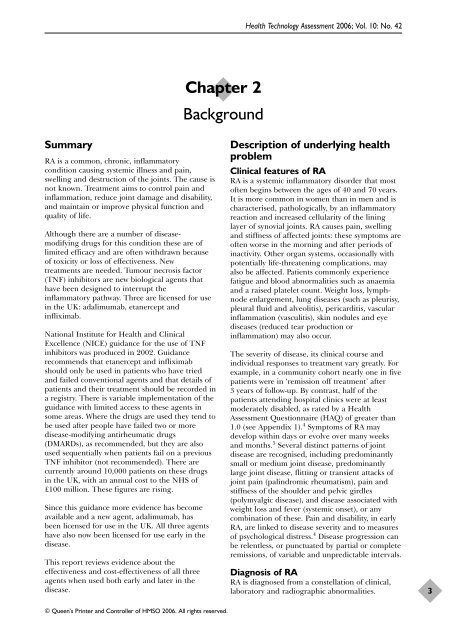A systematic review of the effectiveness of adalimumab
A systematic review of the effectiveness of adalimumab
A systematic review of the effectiveness of adalimumab
Create successful ePaper yourself
Turn your PDF publications into a flip-book with our unique Google optimized e-Paper software.
Summary<br />
RA is a common, chronic, inflammatory<br />
condition causing systemic illness and pain,<br />
swelling and destruction <strong>of</strong> <strong>the</strong> joints. The cause is<br />
not known. Treatment aims to control pain and<br />
inflammation, reduce joint damage and disability,<br />
and maintain or improve physical function and<br />
quality <strong>of</strong> life.<br />
Although <strong>the</strong>re are a number <strong>of</strong> diseasemodifying<br />
drugs for this condition <strong>the</strong>se are <strong>of</strong><br />
limited efficacy and are <strong>of</strong>ten withdrawn because<br />
<strong>of</strong> toxicity or loss <strong>of</strong> <strong>effectiveness</strong>. New<br />
treatments are needed. Tumour necrosis factor<br />
(TNF) inhibitors are new biological agents that<br />
have been designed to interrupt <strong>the</strong><br />
inflammatory pathway. Three are licensed for use<br />
in <strong>the</strong> UK: <strong>adalimumab</strong>, etanercept and<br />
infliximab.<br />
National Institute for Health and Clinical<br />
Excellence (NICE) guidance for <strong>the</strong> use <strong>of</strong> TNF<br />
inhibitors was produced in 2002. Guidance<br />
recommends that etanercept and infliximab<br />
should only be used in patients who have tried<br />
and failed conventional agents and that details <strong>of</strong><br />
patients and <strong>the</strong>ir treatment should be recorded in<br />
a registry. There is variable implementation <strong>of</strong> <strong>the</strong><br />
guidance with limited access to <strong>the</strong>se agents in<br />
some areas. Where <strong>the</strong> drugs are used <strong>the</strong>y tend to<br />
be used after people have failed two or more<br />
disease-modifying antirheumatic drugs<br />
(DMARDs), as recommended, but <strong>the</strong>y are also<br />
used sequentially when patients fail on a previous<br />
TNF inhibitor (not recommended). There are<br />
currently around 10,000 patients on <strong>the</strong>se drugs<br />
in <strong>the</strong> UK, with an annual cost to <strong>the</strong> NHS <strong>of</strong><br />
£100 million. These figures are rising.<br />
Since this guidance more evidence has become<br />
available and a new agent, <strong>adalimumab</strong>, has<br />
been licensed for use in <strong>the</strong> UK. All three agents<br />
have also now been licensed for use early in <strong>the</strong><br />
disease.<br />
This report <strong>review</strong>s evidence about <strong>the</strong><br />
<strong>effectiveness</strong> and cost-<strong>effectiveness</strong> <strong>of</strong> all three<br />
agents when used both early and later in <strong>the</strong><br />
disease.<br />
Chapter 2<br />
Background<br />
© Queen’s Printer and Controller <strong>of</strong> HMSO 2006. All rights reserved.<br />
Health Technology Assessment 2006; Vol. 10: No. 42<br />
Description <strong>of</strong> underlying health<br />
problem<br />
Clinical features <strong>of</strong> RA<br />
RA is a systemic inflammatory disorder that most<br />
<strong>of</strong>ten begins between <strong>the</strong> ages <strong>of</strong> 40 and 70 years.<br />
It is more common in women than in men and is<br />
characterised, pathologically, by an inflammatory<br />
reaction and increased cellularity <strong>of</strong> <strong>the</strong> lining<br />
layer <strong>of</strong> synovial joints. RA causes pain, swelling<br />
and stiffness <strong>of</strong> affected joints: <strong>the</strong>se symptoms are<br />
<strong>of</strong>ten worse in <strong>the</strong> morning and after periods <strong>of</strong><br />
inactivity. O<strong>the</strong>r organ systems, occasionally with<br />
potentially life-threatening complications, may<br />
also be affected. Patients commonly experience<br />
fatigue and blood abnormalities such as anaemia<br />
and a raised platelet count. Weight loss, lymphnode<br />
enlargement, lung diseases (such as pleurisy,<br />
pleural fluid and alveolitis), pericarditis, vascular<br />
inflammation (vasculitis), skin nodules and eye<br />
diseases (reduced tear production or<br />
inflammation) may also occur.<br />
The severity <strong>of</strong> disease, its clinical course and<br />
individual responses to treatment vary greatly. For<br />
example, in a community cohort nearly one in five<br />
patients were in ‘remission <strong>of</strong>f treatment’ after<br />
3 years <strong>of</strong> follow-up. By contrast, half <strong>of</strong> <strong>the</strong><br />
patients attending hospital clinics were at least<br />
moderately disabled, as rated by a Health<br />
Assessment Questionnaire (HAQ) <strong>of</strong> greater than<br />
1.0 (see Appendix 1). 4 Symptoms <strong>of</strong> RA may<br />
develop within days or evolve over many weeks<br />
and months. 5 Several distinct patterns <strong>of</strong> joint<br />
disease are recognised, including predominantly<br />
small or medium joint disease, predominantly<br />
large joint disease, flitting or transient attacks <strong>of</strong><br />
joint pain (palindromic rheumatism), pain and<br />
stiffness <strong>of</strong> <strong>the</strong> shoulder and pelvic girdles<br />
(polymyalgic disease), and disease associated with<br />
weight loss and fever (systemic onset), or any<br />
combination <strong>of</strong> <strong>the</strong>se. Pain and disability, in early<br />
RA, are linked to disease severity and to measures<br />
<strong>of</strong> psychological distress. 4 Disease progression can<br />
be relentless, or punctuated by partial or complete<br />
remissions, <strong>of</strong> variable and unpredictable intervals.<br />
Diagnosis <strong>of</strong> RA<br />
RA is diagnosed from a constellation <strong>of</strong> clinical,<br />
laboratory and radiographic abnormalities.<br />
3
















